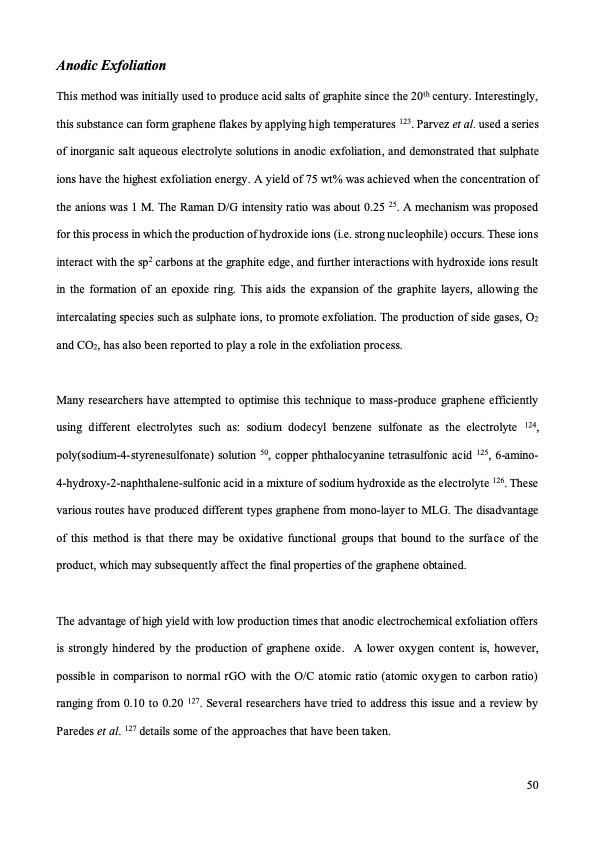
PDF Publication Title:
Text from PDF Page: 050
Anodic Exfoliation This method was initially used to produce acid salts of graphite since the 20th century. Interestingly, this substance can form graphene flakes by applying high temperatures 123. Parvez et al. used a series of inorganic salt aqueous electrolyte solutions in anodic exfoliation, and demonstrated that sulphate ions have the highest exfoliation energy. A yield of 75 wt% was achieved when the concentration of the anions was 1 M. The Raman D/G intensity ratio was about 0.25 25. A mechanism was proposed for this process in which the production of hydroxide ions (i.e. strong nucleophile) occurs. These ions interact with the sp2 carbons at the graphite edge, and further interactions with hydroxide ions result in the formation of an epoxide ring. This aids the expansion of the graphite layers, allowing the intercalating species such as sulphate ions, to promote exfoliation. The production of side gases, O2 and CO2, has also been reported to play a role in the exfoliation process. Many researchers have attempted to optimise this technique to mass-produce graphene efficiently using different electrolytes such as: sodium dodecyl benzene sulfonate as the electrolyte 124, poly(sodium-4-styrenesulfonate) solution 50, copper phthalocyanine tetrasulfonic acid 125, 6-amino- 4-hydroxy-2-naphthalene-sulfonic acid in a mixture of sodium hydroxide as the electrolyte 126. These various routes have produced different types graphene from mono-layer to MLG. The disadvantage of this method is that there may be oxidative functional groups that bound to the surface of the product, which may subsequently affect the final properties of the graphene obtained. The advantage of high yield with low production times that anodic electrochemical exfoliation offers is strongly hindered by the production of graphene oxide. A lower oxygen content is, however, possible in comparison to normal rGO with the O/C atomic ratio (atomic oxygen to carbon ratio) ranging from 0.10 to 0.20 127. Several researchers have tried to address this issue and a review by Paredes et al. 127 details some of the approaches that have been taken. 50PDF Image | graphene production via nonoxidizing liquid exfoliation

PDF Search Title:
graphene production via nonoxidizing liquid exfoliationOriginal File Name Searched:
Graphene-R2-review.pdfDIY PDF Search: Google It | Yahoo | Bing
Salgenx Redox Flow Battery Technology: Power up your energy storage game with Salgenx Salt Water Battery. With its advanced technology, the flow battery provides reliable, scalable, and sustainable energy storage for utility-scale projects. Upgrade to a Salgenx flow battery today and take control of your energy future.
| CONTACT TEL: 608-238-6001 Email: greg@infinityturbine.com | RSS | AMP |